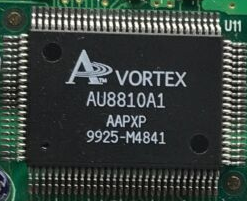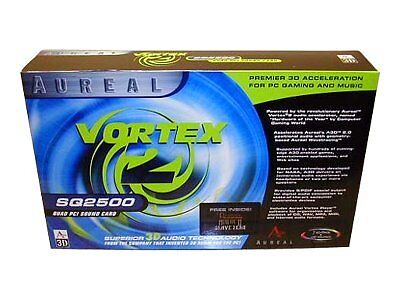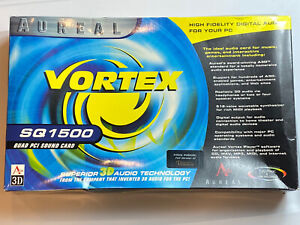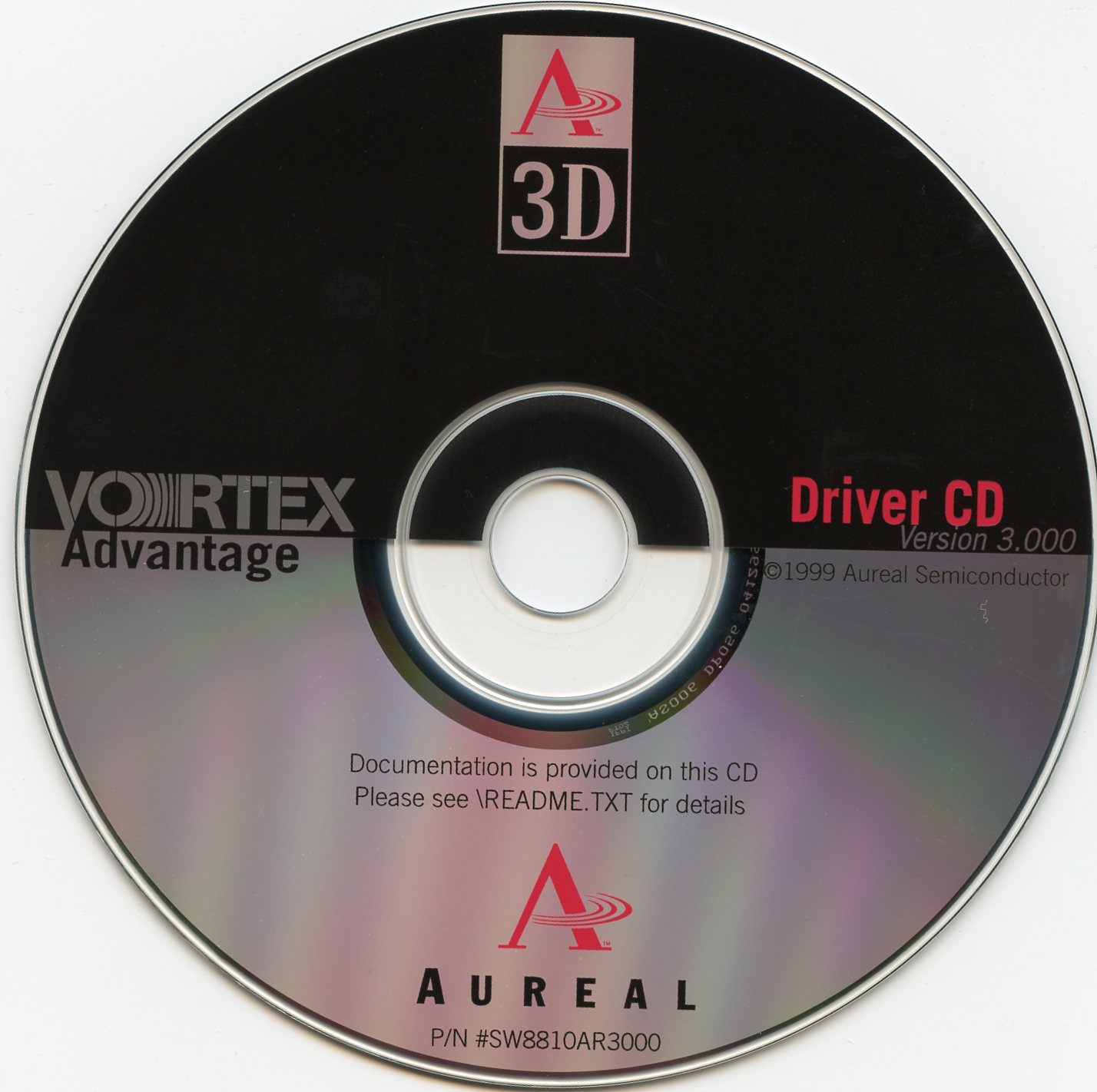 Aureal Semiconductor
Aureal Semiconductor
Aureal Semiconductor was a sound card chipset manufacturer for the IBM PC compatible market in the late 90s. Following the sad demise of the Media Vision company in 1996, the company reformed under this new company name. Aureal were probably most famous for their Vortex line of audio chips that sound card manufacturers based their cards around. Later that same year they merged with Crystal River Engineering whose skills in 3D sound processing led to Aureal producing the Aureal 3D (A3D) chip.
Until Vortex 2 arrived in 1998, Aureal only designed and sold their audio chips - they did not produce their own sound cards - but this changed in 1999 when one of their main partners, Diamond Multimedia, was bought out by S3. Aureal were unhappy with this and the lack of Diamond's promotion of their Monster Sound cards, and so introducted a three-card range of their own comprising Aureal Vortex 2 SQ1500, Aureal Vortex 2 SQ2500 (which sold for $99 for the plain OEM variant), and SQ3500 Turbo (a SQ2500 with DSP daughterboard installed that added a Dolby Digital decoder).
Aureal lasted until a buyout from Creative Labs in September 2000 after a lawsuit that went in the favour of Aureal, but the costs of the lawsuit (and lost investor confidence) pushed them into bankruptcy.
Sound Card Chipsets
|
|
|
*These cards used a custom version of the Vortex chip, and so typically require the use of drivers from the sound card manufacturer instead of the Aureal reference drivers.
Some of the games that directly supported A3D include Half Life, Unreal, Quake II, Star Wars: Jedi Knight, Quake III and SiN. For the full list of 3D audio-supported games, click here.
Vortex 1 was also embedded on a number of motherboards - these had the designation AU8808. Such motherboards include the BCM IN440ZX, Intel 440ZX Napoli, and some from PC Chips where the chip is branded "A3D SoundPro". These PC Chips motherboards may include M559, M570, M571, M573, M575, M577, M715, M717, M720 and M725, though I've not confirmed each of these models. There were at least two driver CDs shipped with PC Chips mobos that definitely contain A3D drivers, version 1.9 and v2.3.
Vortex 2 







Launched: August 1998
Chipset: Vortex AU8830
Bus: PCI
Chip Revisions: A2, B0
Build Codename: ASP403 (Aureal Sound Processor 4th Gen, rev. 03)
The Vortex 2 audio accelerator chip took the original A3D 1.0 to version 2.0, with hardware-accelerated HRTF (Head-Related Transform Functions). It also added a hardware-based 10-bands-per-channel graphic equaliser, 96dB SnR (signal-to-noise ratio), custom crosstalk cancellation circuitry (for improved noise), as well as support for 4-speaker, 5.1 or 7.1 home theatre arrangements. A3D 2.0 builds on the basic concept from A3D 1.0 by adding in "wavetracing" to simulate the effect of a sound wave traveling through a three dimensional environment - all done using the 3D geometry of the room from the games engine. This primarily means reflections off walls, occlusions by walls, Doppler effect, acoustic reverberation, and atmospheric absorption.
![]()
The wavetable synthesizer is as Vortex 1 with 64 total voices, The first 32 voices are loaded into system memory via an up to 4 MB sample instrument file in either .ALR or .DLS (Downloadable Sound) v1.0 format. A further 32 voices can be added which are rendered in software. The DLS format dates back to 1990 and is supported by Creative's Sound Blaster Live! cards as well as any sound card with an Analog Devices AD1888, AD1980 or AD1985.
Revision B of the Vortex 2 chip runs at a slightly faster clock speed than Revision A. Aside from that they are identical.
Aureal boasted at the time that their Vortex2 chip contained 50% more transistors than Creative's EMU10K/1 chip.
A3D 2.0 was fully backward-compatible with A3D 1.0 implemented in the original Vortex chip, and is exceptional with its 3D audio capabilties, especially when using headphones. The 4 MB wavetable samples that come with the drivers are of average quality only, however with third-party wavetable files available this can be improved easily. Wavetable audio support is only available in Windows (or a DOS command prompt inside Windows), not in real DOS.
In pure DOS, Sound Blaster and Sound Blaster Pro emulation is achieved by running a TSR called AU30DOS.COM. It looks for a SET BLASTER= line in your environment variables.
Vortex2, like the Vortex, also provides an "Enhanced Game Port" mode where the soundcard handles polling the
joystick. This allows for certain peripherals that send and receive digital data packets over the game port to work.
Cards that used the AU8830 include:
|
|
Some of the cards above only have a 2-channel CODEC, e.g. Turtle Beach Montego II, whereas others such as the SQ2500 ("SuperQuad") and SQ3500 have 4 channels.
The Aureal Vortex 2 SQ2500 was Aureal's own sound card. Up until this point they had not ventured into the world of producing their own sound card, having worked exclusively on selling their 3D audio chip separately to actual sound card manufacturers. The SQ2500 added an S/PDIF RCA jack to the faceplate which was fairly rare on Vortex 2-equipped cards (some have a TOSLink digital out instead), as well as a Wave Blaster-compatible wavetable header. The card was also bundled with games titles Drakan:Order of the Flame (Psygnosis), Heretic II (Raven Software), and a demo of Slave Zero (Accolade).
They also later re-sold Diamond's own MX300 card, branded as the SQ2200 (I guess the lower number was chosen so as not to make it appear a better card than their SQ2500).
Windows support for Vortex 2 focussed on Windows 95. 98 and ME. There are some beta drivers out there for Windows 2000, but this was released right around the time Aureal were going bankrupt. The first release of Windows XP included drivers for Vortex 2-based cards which provided decent support. Microsoft later released updated drivers (2 5.12.01.156), which removed many features (Aureal A3D support, hardware acceleration, Aureal wavetable and S/PDIF support). Using the Win 95/98 driver versions 4.06.2048 or 4.06.2050 apparently work well with Windows 2000.
Vortex 2 was also included in some Sony VAIO and Alienware PCs at the time.
Also of note is Creative Labs' EMU10K-based cards such as the SB Live! range which only emulates A3D1.0, it is known that this isn't true A3D - instead the wrapper simply takes A3D instructions and converts them into DirectSound 3D instructions, which results in a poorer 3D solution than true A3D. So for A3D 1.0 or 2.0 titles, use a true Aureal Vortex 2-based card. If you want EAX 3D audio in your games, use a Creative card that supports it (Aureal cards don't support EAX). It is entirely feasible to run a Vortex 2 card alongside an EAX-supported card for the broadest flexibility.
More Images
Vortex Advantage 







Launched: >1998(?)
Chipset: Vortex AU8810
Bus: PCI
A flavour of Vortex 1 was re-released after Vortex 2, called Vortex Advantage. This was essentially a cost-reduced card based on Vortex 1 but with the 10-band graphic equalizer from the Vortex 2, and 256-voice MIDI. It sold for as little as $45 for a full sound card.
The cards were basic, with just a CD-In port on the card face, and the usual base Microphone, Line-In and Speaker Out ports on the faceplate, along with the Game/MIDI port. They did not come with a wavetable connector or any other jumpers. The accompanying CD-ROM comprised drivers for Windows 95/98 and NT 4.0, a quick start guide in PDF format, and four demo programs.
According to an Aureal spec sheet, the Advantage had the following specifications:
- Wolfson Microelectronics' dual-channel 18-bit stereo codec XWM9701A complies with the AC'97 ver specification. 1.03
- 48 kHz sampling supported
- Built-in analog mixer with support for four different stereo inputs
- Full-duplex, 48kHz digital recording and playback
- 8 streams of A3D 1.0 with DirectSound3D support
- 16 DirectSound acceleration threads
- 256-voice wavetable synthesizer (4 MB samples)
- Reverb and effects (chorus, delay, flange, distortion, wow, etc.)
- General MIDI and DLS 1.0 support
- Sound Blaster Pro support in MS-DOS and MS-DOS window
- 10-band stereo equalizer with spectrum analyzer
The wavetable synthesizer is the same as that found in Vortext 1.
The graphic equaliser utility has 5 preset modes and a 'user' mode. Advantage runs well in DOS, including the wavetable synth.
Cards that used the AU8810 include:
- Aureal Vortex "SuperQuad" SQ1500
- Aureal Vortex Advantage PCI
- I/O Magic MagicWave V1 A3D PCI
- Hi-Val PCI A3D Advantage
- Absolute Outrageous 3D Sound Lite
You need a specific driver if you want to get quad-channel audio and S/PDIF output from the AU8810, as the Aureal reference driver only supports two-channel and no S/PDIF.
More Images



